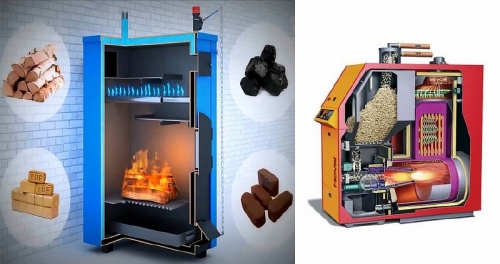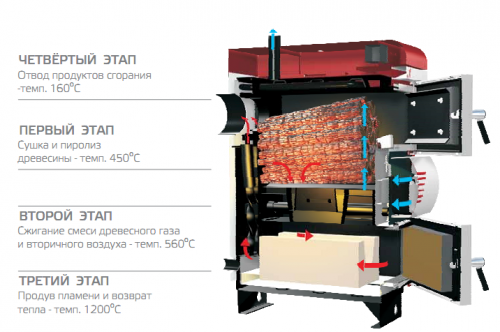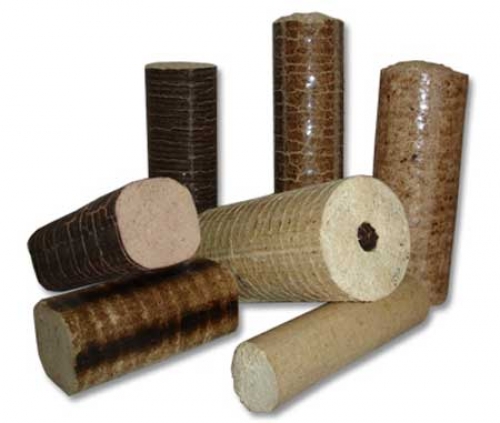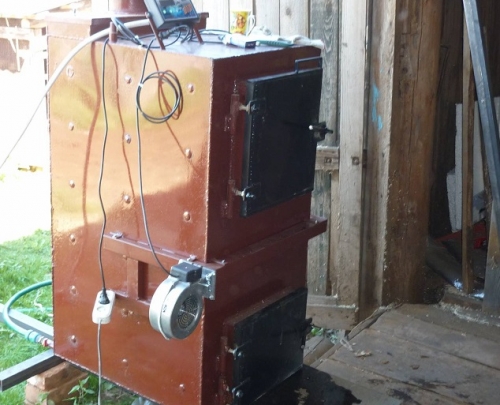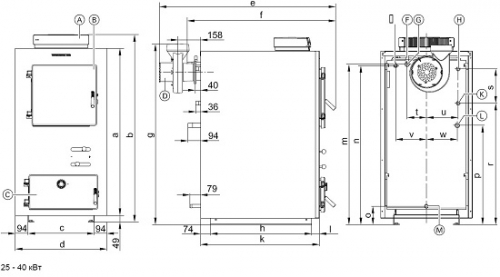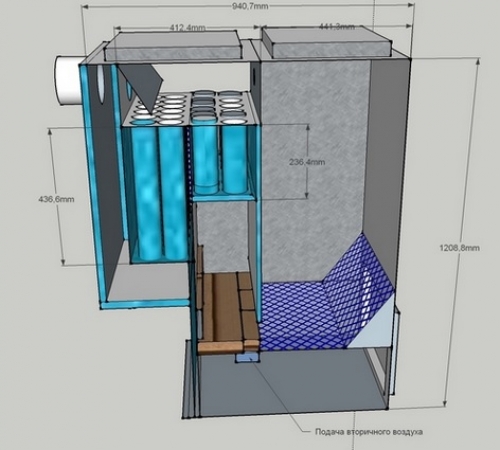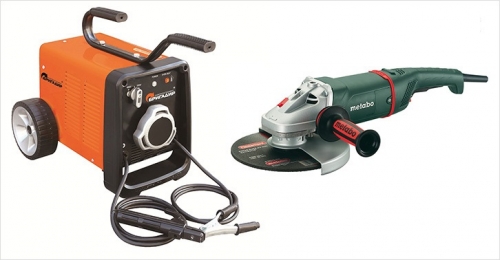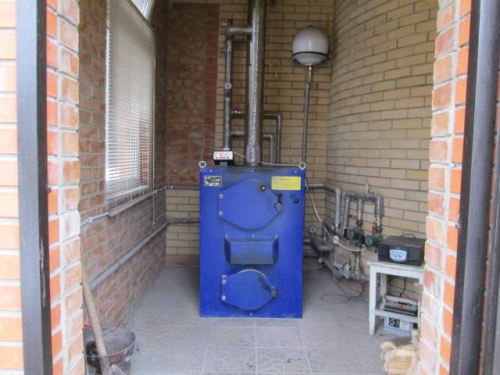The foundation of the support of the whole house, depends on its design and strength ...
|
|
Correctly and high -quality insulated ceiling can be significantly saved on ... |
From such an event as sealing seams in panel houses, in... |
DIY pyrolysis boiler

Gas generating and pyrolysis boilers have gained popularity when heating residential and industrial premises. The principle of their work is somewhat different from the usual solid fuel models. However, a more complex design of the device provides a lot of advantages and saving money spent on heating.
- The principle of operation and the device of a pyrolysis boiler
- Advantages and disadvantages of a pyrolysis boiler
- Fuel for a pyrolysis boiler
- Do or not a pyrolysis boiler yourself
- Solid fuel pyrolysis boiler with your own hands: step -by -step assembly
- Put the boiler into operation
- Safety precautions
The principle of operation and the device of a pyrolysis boiler
The main element of any heating system is the boiler. The task of the boiler is heated using the fuel of the coolant, and then transfer it to the heating system. One of the most promising and economical household boilers are pyrolysis boilers.
A pyrolysis boiler is a subspecies of a solid -fuel boiler (usually a hot water) in which the process of combustion of fuel and flying substances emerging from it occurs separately. Such boilers are also called gas generator.
Pyrolysis The ability of wood to decompose during burning for solid residues (coal) and gas. Two conditions must be met for two processes:
- heat;
- lack of oxygen.
The necessary conditions are provided by a special design implemented in pyrolysis boilers. In such equipment, the furnace is divided into two parts. In the loading chamber (first part) it burns and with a lack of oxygen, fuel is pyrolymized. In the combustion chamber (second part), the release gases are burned out into this compartment, secondary air enters. A similar design minimizes heat removal from the primary load chamber.
Both compartments are divided by a grate, which is placed fuel. The air is supplied from top to bottom and passes through the fuel is a characteristic difference between pyrolysis -type boilers and other heat -generating plants. The firebox has increased aerodynamic resistance, so the arrangement of traction is usually forced. As a rule, a smoke exhaust or a blower fan is used.
The work of pyrolysis boilers of prolonged combustion occurs in the following sequence:
- Firewood (or other fuel) is placed on the grate and set on fire.
- After closing the door, the smoke exhaust is launched.
- Under the influence of high temperature (up to +800C), carbonization occurs, wood gas is released.
- The released products (carbon monoxide, hydrogen, hydrocarbons and nitrogen) come under the grate.
- Production is added to the products of the pyrolysis - the volatile substances are gradually burning, and part of the heat is returned to the layer of firewood located from the bottom.
- Heat is used to heat air heaters, water.
Advantages and disadvantages of a pyrolysis boiler
Pyrolysis boilers gained their popularity thanks to a number of advantages:
- Complete combustion of fuel ensures the efficiency of combustion. In addition, this quality allows you to clean the ash and gas tract less often.
- The adjustable combustion process allows you to increase the duration of the combustion of one furnace (about 12 hours).
- The emissions of harmful substances into the atmosphere are reduced by the temperature in the chamber from above suppresses CO.
- Large, unsolved firewood are suitable for the furnace.
- The possibility of complete automation of the boiler and connection to any heating system.
- The boiler can dispose of rubber, plastic and polymers, without polluting the environment.
Important! Gas generating boilers are more effective than traditional. The efficiency of the pyrolysis boiler reaches 85%, and the capacity of the equipment can be adjusted in the range of 30-100%

The disadvantages of pyrolysis boilers include:
- Large dimensions of the installation.
- The efficiency of the boiler is sharply reduced if you place a fuel of high humidity in it.
- The energy dependence of the boiler without a smoke carcass will not work.
- On low loading (less than 50%), unstable burning and the appearance of tar in gas sections are noted.
- You cannot organize an automatic supply of firewood.
- High cost of pyrolysis boilers. You can save if you make a boiler yourself. But the manufacture of the boiler is a rather complicated process that requires accurate calculations, the development of the drawing and competent assembly.
Fuel for a pyrolysis boiler
It is better to use fuel pellets or firewood for pyrocottles. The wood can be loaded with a diameter of 100-250 mm, 400-450 mm long. The dimensions of the fuel briquettes are 300x30 mm. Small wood waste and sawdust can be burned along with firewood, but they should be no more than 30% of the total volume of the loading camera.
The boiler works at maximum power if dried wood is used. In addition, this condition allows you to extend the life of the installation.
The heat of combustion of 1 kg of firewood with a moisture content of 20% is 4 kW/hour, and wood with a moisture content of 50% - 2 kW/hour
In industrial installations, diluted wood tars can use pyrolysis oil. The material has a high heat -intensive capacity of about 40,000 kJ/kg, but the pyromenon has a strong acidic reaction, which negatively affects the lining and metal. Therefore, its use in household boilers is not desirable.
Do or not a periline boiler on your own
The pyrolysis boiler is modern and effective, but expensive. The cost of a simple domestic boiler is at least $ 1,000, the prices of imported gas generator units are an order of magnitude higher.
It is quite possible to make a pyrolysis boiler yourself or order the manufacture of installation from specialists. The second option will cost more than the first, but in comparison with the purchase of new equipment, it will be possible to save a considerable amount of money (depending on the size of the boiler).
Homemade pyrolysis boiler: photo
Of course, the process of assembling the boiler cannot be called absolutely cheap and simple. Before the manufacture of equipment, it is necessary to evaluate your own capabilities and strength, to study all the information on the constituent elements and the operation of the boiler.
Solid fuel pyrolysis boiler with your own hands: step -by -step assembly
Development of a drawing and calculation of a pyrolysis boiler
When working, it is important to accurately follow the developed drawings of a pyrolysis boiler. Here is a drawing of the most common design, which is used for independent assembly. The heating apparatus is designed for 40 kW. The design of the device can be changed, but the internal volume should remain unchanged.
Deciphering the drawing:
A controller of the boiler circuit;
B door of loading;
From the door of the ash;
D smoke car;
E coupling for the sensor of the thermal fuse (R 1/2);
F Pipe of the emergency system (the safety valve is mounted in the feeding line using the tee in the assembly with the security group);
G feeding the trunk of the boiler circuit;
H Submarine of chilled water of the protective heat exchanger, R;
K the hot water supply of the protective heat exchanger, R;
L reverse trunk of the boiler circuit;
M Expective tank and emptying pipe.
For a private house, a 40 kW boiler is usually enough. In the manufacture of installation of a larger/smaller power, it is necessary to adjust the other parameters of the boiler accordingly. The correct ratio of the size of the pyrolysis boiler guarantees the efficiency and durability of the installation.
Corolithic boiler compliance table of the generated power
Important! For a small house, a boiler with a capacity of 25-30 kW will be the best option. Manufacturing compact equipment will save money and time for assembly
3D- visualization of the connection of all nodes of the boiler will help to understand the internal structure of the boiler.
3D pyrolysis boiler diagram
Tools and materials
The following tools will be needed for work:
- welding machine (preferably, direct current);
- electric drill and a set of drills for metal;
- bulgarian;
- angle grinding machine;
- plasmoresis or gas cutter to create a large diameter hole (if you have experience, this work can be made by a grinder);
- locksmith instruments (file, hammer, chisel, clamps).
List of necessary materials:
- Sheet steel (5 mm) for the manufacture of a burning chamber and a gasifying chamber. Sheet steel (4 mm) for external sheathing. The total meter of steel sheets is 8-10 sq.m.
- Pipe for heat exchangers: length about 10 m, diameter 57 mm, wall thickness 4.5 mm.
- Pipe for Borov: length 0.5 m, diameter 159 mm, wall thickness 4.5 mm.
- Fireproof chamotopic brick 20-25 pcs.
- Profile pipe 60x30x2 and 80x40x2 2 meters.
- A pipe 2 m long, with a diameter of 32 mm, wall thickness 4.5 mm.
- Steel strip 30x4 mm- 2 m.
- Circle cuts 230 mm, 125 mm for 10 pcs.
- Electrodes 5 packs.
- Grinding circles 125 mm 5 pcs.
- Centrifugal Dutyeva Fan.
- Temperature sensor.
Assembly of a pyrolysis boiler
Here are the main stages for the manufacture of a pyrolysis boiler:
- Make an optimal plan for the cutting of workpieces. It is advisable to cut the metal sheets immediately on the metal depot. Of course, this service is not free, but it gives significant advantages: an even cut and time savings.
- Production of the inner part of the boiler welding of the burning and gasification chamber.

- After creating the frame of the cameras, weld the ducts and the rear wall in the gasification compartment. Cut the hole in the back wall under the chimney channel.
- Enter the secondary air supply pipe into the burning chamber. The pipe is associated with the boiler facade using a profile pipe with a size of 20x20 mm.
- Making the heat exchanger. Burn with a gas cutter on the prepared plate a hole with a diameter of 57 cm under the pipes.
- Cut the pipes of the heat exchanger, put on the supporting plates and grab in several places welding. Check the dimensions and finally boil the joints.
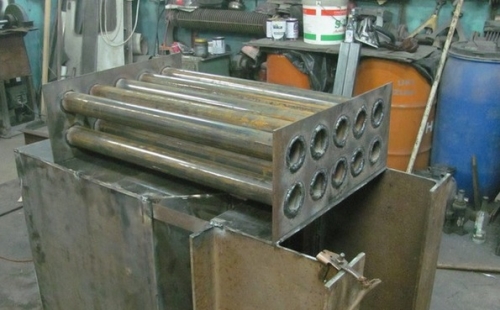
- The heat exchanger weld to the boiler. Make and install the throttle flap of the chimney.
- In the front wall of the boiler chamber, make holes for the pipes of primary/secondary air. Install the front wall in its place.
- Borov and the back cover are weld in the place of the throttle. After that, clean all the seams with a grinding disk. The inner box of the boiler is assembled.
- To fasten the external sheathing, weld the corner of the corner No. 25 on the boiler housing.
- On the cut sheet of the sheathing, make through holes for attaching to the boiler housing.
- Compare holes with corners and weld so that the skin is firmly fastened with the base. Sheathe all sides of the installation (except the upper cover). Boil and clean the joints.
- Checking seams. Dive all holes (input/output/drain of the coolant) and fill the boiler with water through the top cover. Place the leakage place with chalk.
- The shutters are adjusted with threaded hairpins. Cover the air holes with a common casing.
- Make and hang the doors of the boiler chambers. Doors should be finished with cast -iron plates or chamotis brick.
- From sawed brick, create a lining for the lower part of the gasification chamber.
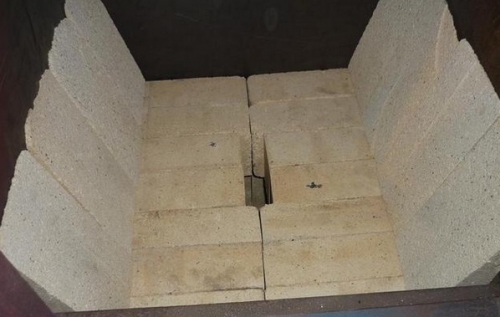
- On the profile pipe of the duct, weld the flange, fix the centrifugal fan.
- Make a lining of the burning chamber with a shomato brick.
- In the channels of the heat exchanger gas transfer, place turbuilders (turbuitors), they help improve heat transfer and clean the gas meters of deposits. Attach to the turbines to the rod.
- Check the boiler tightness and configure the pressure of 4 bar. To do this, the boiler must be filled with water and connected to it.
- On the supply pipe in the heating system, mount the boiler security group (manometer, automatic air vent and emergency valve).
- It is advisable to equip a pyrolysis installation with automation with thermal attitters who will monitor the operation of the boiler, stop/launch.
Making pyrolysis boilers: video
Put the boiler into operation
Before starting the boiler, it must be connected to the chimney and filled with water. The boiler must have a thermometer to control the temperature of the coolant. To install the thermometer in the projects of the boilers, holes are provided.
The commissioning of the pyrolysis boiler system into operation occurs in the following sequence:
- Submit the fan to the mains and check its work. Put air shutters for the middle position.
- Put the paper in the gasification chamber, and lay out a small amount of firewood on top of it. Close the door of the gasification chamber.
- Open the throttle flap of the chimney, turn on the fan and set fire to the paper.
- When the firewood is well flared up, the chimney shallow must be closed.
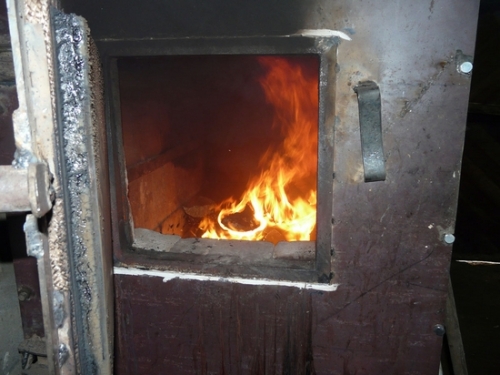
- The ignition of the burning of the combustion of pyrolysis gases is performed through the lower combustion chamber.
- The intensity/color of the flame is regulated by the movement of the damper. With proper tuning of the boiler, the flame of yellow-white color.
- Slick on how much time the water in the boiler will boil. When reaching a temperature of +100C, turn off the fan. After that, the torch will go out, and the water will begin to cool gradually.
Safety precautions
When installing the boiler, fire safety requirements must be observed:
- For a pyrolysis type heating boiler, a separate boiler room is necessary.
- It is necessary to install the boiler on a brick or concrete base.
- The size of the ventilation hole in the room should be at least 100 sq.m.
- The distance from the boiler to walls is at least 20 cm.
- In front of the boiler, it is necessary to put sheet metal with a thickness of 2-3 mm.
- The chimney must be isolated by insulation.
Make a decision on the independent manufacture of a pyrolysis boiler carefully. Such an installation is structurally very complicated. Of course, it will be possible to save a large amount of money, but to ensure the most effective and safe work, it is necessary to observe numerous nuances and features.

